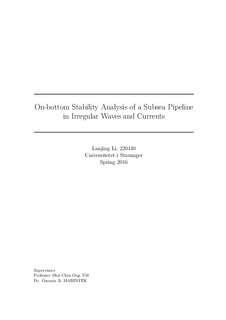| dc.description.abstract | Pipelines in a subsea environment are exposed to a very complex system of hydrodynamic
reaction. The on-bottom stability has long been a important study for offshore practice.
The soil types, wave conditions as well as the structure itself are considered to be the
main focus of the on-bottom stability analysis for a subsea pipeline.
The objective of this thesis is to study the on-bottom stability in a series of complex
environmental conditions through the dynamic analysis, as well as the generalized stability
method and absolute lateral static stability method. The effect of different parameters
regarding stability is investigated through the sensitivity analysis. Models will be built
using PONDUS, a software developed by MARINTEK for the dynamic on-bottom stability
analysis. The linear wave theory, the JONSWAP spectrum and the energy-based
soil model will be considered for irregular waves and soil-pipe interactions respectively.
Based on the different case set-ups, the results will be compared and discussions will be
made on the methodology of pipeline stability analysis, considering the sensitive variables
as follows.
Both regular waves and irregular waves have been studied in the past. Behaviours of
the pipe in irregular waves are studied further in this thesis based on the previous research.
Important development patterns and characteristic values such as displacement,
forces and velocity will be compared between cases with regular and irregular waves. The
mechanisms are further discussed based on simulation results. Same values taken for the
wave height and wave period of regular waves, the significant wave height and the peak
wave period of irregular waves. Results indicate that the maximum wave-induced water
particle velocity is larger in irregular waves. It suggests that when considering the environmental
condition, 10-year return currents and 100-year return irregular waves is the
most critical load combination. These recommendations are important to obtain a more
realistic and reliable model among all the cases in the present study for the on-bottom
stability analysis. Furthermore, the stair-like development pattern of dynamic displacement
is quite distinguishable when the pipeline is exposed to underwater environment
with irregular waves.
The pipe-soil interaction is also investigated in this thesis. Past studies took only one
single type of soil for the investigation of pipe-soil interactions. However, the seabed soil
condition is actually more complicated in reality, considering that pipes run a very long
distance and will pass several areas of different soil types. Three typical values of the
friction coefficient are applied for the pipe-clay model and pipe-sand model respectively.
The maximum displacement seems to decrease as the friction coefficient increases for
both the pipe-sand model and the pipe-clay model. The friction coefficient and the relative
velocity between the pipe and the water particles, and the penetration will interact
with each other. While for the pipe-sand model, the different friction coefficients do not
seem to affect the displacement in the same way as it is for the pipe-clay model. This
is likely due to the varying residual force that interacts differently and further leads to
a different interaction between the soil resistance force, the relative penetration and the
displacement. It appears that the displacement and friction coefficient does not interact
with each other in any explicit pattern. But in general, the penetration and accumulated
displacement tends to grow larger as the friction coefficient decreases. [...] | nb_NO |

